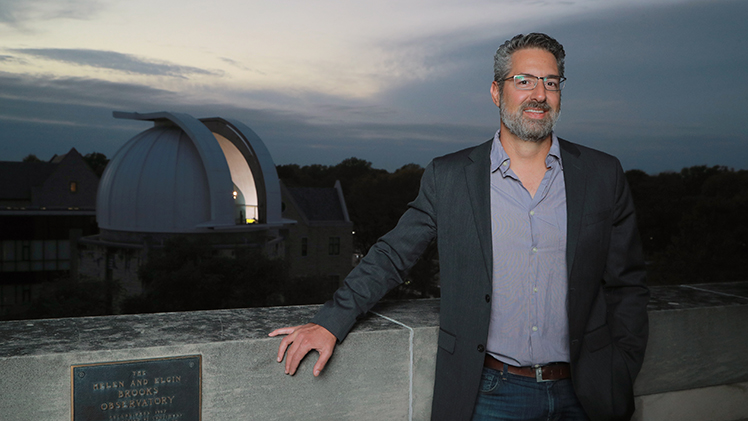The Space Telescope Science Institute recently announced the third and latest round of research proposals that will make use of the James Webb Space Telescope, with UToledo researchers leading three of the 253 observational, 25 archival and 12 theory projects making the cut.
More than 6,000 investigators submitted proposals in the most competitive cycle to date.

The James Webb Space Telescope Users Committee is chaired by Dr. J.D. Smith, a professor and director of the Ritter Astrophysical Research Center.
“The Telescope Allocation Committee received 10 times more proposals than it could possibly allocate,” said Dr. J.D. Smith, a professor and director of the Ritter Astrophysical Research Center at The University of Toledo, who chaired one of 16 topical review panels in February. “It’s exciting because it means the astronomical community is absolutely in love with the James Webb. But it’s also a real challenge because it means you have no choice but to leave wonderful science on the cutting room floor.”
Smith expects this sky-high demand to be among the topics of conversation when the James Webb Space Telescope Users Committee meets later this month in Baltimore. Smith is the chair of this committee, which is separate from the review panels and executive committee that recommend which proposals be allocated hours on each cycle on the James Webb. The users committee instead acts as a liaison between users of the James Webb Space Telescope and its operators at the Space Telescope Science Institute.
Consider the much-debated period of exclusivity, for example. The users committee has weighed strong and varied opinions on this one-year period before data derived from most observing programs becomes public. Established to give investigators protected time to work with and analyze their data, and to accommodate researchers with heavy teaching or other responsibilities, it may also slow progress by a global community of astronomers who often eye the same or similar targets in their proposals.
The users committee also has waded into questions on the way data is downloaded, calibrated and processed and, after an unexpected run-in with a micrometeor within months of the telescope’s launch on Dec. 25, 2021, established best practices on how to mitigate these hazards and protect the telescope’s valuable optics going forward.
The committee meets in person twice a year in Baltimore, welcoming specialists on a wide variety of topics who help shape the recommendations they put to the Space Telescope Science Institute.
“It’s been a lot of fun,” said Smith, who’s in his second year as chair of the users committee. “It’s early in the days of the mission, so things are improving and changing fast. I’ve learned a lot.”
Smith traces his fascination with the cosmos to a childhood spent gazing up at the night sky of rural Kentucky. He earned a bachelor’s degree in physics from the Massachusetts Institute of Technology in 1995, followed by a master’s and then a doctorate in astronomy from Cornell University in 1998 and 2001. After a post-doctoral research fellowship and later employment at the University of Arizona’s Steward Observatory, he joined the faculty at UToledo in 2008.
His research explores the physical conditions of interstellar material as a tool for understanding galaxy evolution, an area in which the latest space telescope is particularly valuable. The James Webb specializes in infrared astronomy, which in effect means that it observes at wavelengths that are uniquely able to reveal what’s hiding behind the dust of that interstellar material.
Smith has worked with infrared and sub-millimeter-wave observing facilities from the ground and space, and credits his experience with NASA’s Spitzer Space Telescope, specifically, with positioning him well to contribute to the James Webb Space Telescope Users Committee. It shares similarities with what’s lauded as the largest, most powerful and most complex telescope ever launched into space.
Smith can personally attest to that power as one of four UToledo faculty members to have a successful first-cycle proposal on the space telescope. UToledo researchers have led at least one research project on each cycle since on the James Webb, with two faculty members and one graduate as the latest to receive news of a successful proposal in the just-announced third cycle.
Dr. Tom Megeath, Distinguished University Professor of Astronomy, is principal investigator on a proposal looking at protostars, and Dr. Eli Visbal, an assistant professor in the Department of Physics and Astronomy, will explore ways to use data from the space telescope to address challenges for an emerging observational technique called intensity mapping. Mandy Caputo, a doctoral student studying astrophysics with Dr. Rupali Chandar, her advisor and professor and associate chair of the Department of Physics and Astronomy, will observe a nearby extreme star-forming galaxy called NGC 1614.
Smith’s first-cycle observing program explored hydrocarbons in what’s known as the Pinwheel Galaxy, and he anticipates his research will hit academic journals this spring.
“The data have been amazing,” Smith said, comparing it to the data he’s previously received on the Spitzer Space Telescope, which also specialized in infrared astronomy until it was deactivated in 2020. “You can get much closer to the action. It’s much, much sharper.”
Smith said he expects the demand for hours on the James Webb to continue, and the impressive number of proposals that his and other review panels fielded in the most recent cycle to raise new questions going forward for the users committee.
“How do we cope with this much success?” he said.
“How do we cope with the size of this proposal review process, which is fully volunteer and widely respected?” he continued. “How do we make it more efficient? How do we make it more rewarding?
“One of the fun things about doing these review panels is you get a front-row seat to what latest mysteries of the universe are emerging with the James Webb. It’s really an exciting time to be an astronomer. It’s a lot of work to volunteer on a panel, but it’s fun to be in the mix.”